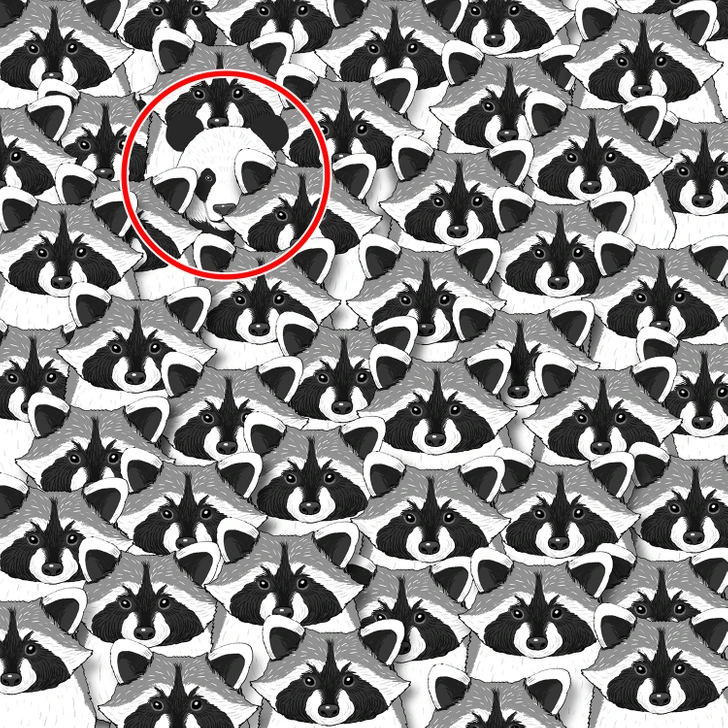In today’s fast-paced world, many of us often overlook the finer details in our surroundings. Whether it’s misplacing a set of keys or failing to notice the obvious, we all have moments when our observational skills aren’t quite up to par. However, some individuals pride themselves on their keen eye for detail, and for those, a visual challenge can be both fun and rewarding.
One such challenge that’s been making the rounds on social media asks participants to locate a panda hidden among a group of raccoons. At first glance, it seems like a simple enough task, but as many who’ve tried it will attest, it’s more difficult than it appears.
The challenge itself is deceptively simple. You’re presented with an image filled with raccoons, each with their characteristic black and white markings, bushy tails, and curious faces. Somewhere within this crowd is a single panda, which, with its similar black and white fur pattern, blends almost seamlessly into the group. The goal is to find the panda as quickly as possible – ideally within seven seconds.
This kind of puzzle plays on our brain’s ability to recognize patterns and details. While raccoons and pandas share some color similarities, their differences are also clear to a trained eye. Raccoons typically have more defined facial markings, including a mask-like pattern around their eyes, whereas pandas have broader, rounder faces and distinct black patches over their eyes.
Despite these differences, our brains can sometimes struggle to differentiate between the two in a crowded image, especially under time pressure. This is because our brains are wired to see what they expect to see, and in this case, the expectation is set by the overwhelming number of raccoons. The panda, cleverly hidden and camouflaged, is an unexpected element that can easily be missed.
Visual puzzles like this one are not just fun; they also serve a purpose. They can help improve concentration and attention to detail, which are essential skills in many areas of life. By challenging our brains to focus and spot the differences, we can train ourselves to become more observant and aware of our surroundings.
Moreover, these kinds of puzzles are also a great way to test and improve your reaction time. The seven-second time limit adds a layer of urgency, pushing your brain to work faster. This not only makes the challenge more exciting but also provides a good workout for your cognitive functions.
But why exactly do we find such puzzles so engaging? The answer lies in our natural curiosity and desire for problem-solving. Humans have an innate drive to seek out patterns and make sense of the world around them. When faced with a puzzle, our brains get a little hit of dopamine – the feel-good chemical – each time we get closer to finding the solution. Successfully finding the panda among the raccoons gives us a sense of accomplishment, no matter how small.
Interestingly, these kinds of visual challenges have a long history. They’re modern-day versions of “spot the difference” puzzles that have been popular for decades in newspapers and magazines. These puzzles have always been a favorite pastime for people of all ages, offering a simple yet effective way to pass the time and exercise the brain.
In today’s digital age, such puzzles have found new life online, where they can be shared widely and enjoyed by millions. Social media platforms, in particular, have made it easy for these challenges to go viral, sparking friendly competition among friends and strangers alike. People love to share their results, often boasting about their success or challenging others to beat their time.
If you haven’t tried the panda among the raccoons challenge yet, give it a shot. It’s a fun way to test your observational skills and see how you stack up against others. Who knows, you might discover that you’re more observant than you thought!

And if you find yourself struggling, don’t worry. The more you practice these kinds of puzzles, the better you’ll get at spotting the subtle differences. So, keep challenging yourself, and soon you’ll be able to spot that hidden panda – or any other hidden object – in no time at all.
In conclusion, whether you’re a casual puzzle solver or someone who prides themselves on their keen eye, challenges like these are a great way to stay sharp and have some fun in the process. So next time you see an image full of raccoons, remember to take a closer look – you never know what might be hiding in plain sight.

Comments are closed.